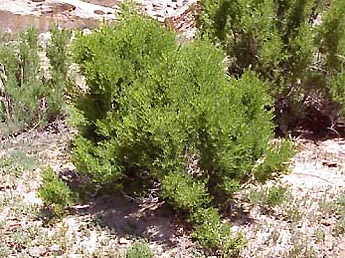Black Greasewood

Common Name(s):
Greasewood
Black Greasewood
Scientific Name:
Sarcobatus vermiculatus (Hook.) Torr.
Scientific Name Synonyms:
None known
Symbol:
SAVE4
Description:
Life Span: Perennial
Origin: Native
Season: Deciduous
Growth Characteristics: A monoecious shrub (male and female plants separate), growing 2 to 8 feet tall, erect or spreading, and much-branched. Flowers June to August and reproduces from seeds and sprouts.
Flowers/Inflorescence: Flowers are unisexual. The numerous male flowers are borne on fleshy, cone-like terminal spikes, whereas female flowers form singly or in pairs in the axils of leaf-like bracts, and are wing-like. Flowers are green, tinged with red.
Fruits/Seeds: Fruit is a small, coriaceous achene, which is winged at the middle and green to tan or reddish. Fruit contains small brown seeds.
Leaves: Leaves of black greasewood are round, linear, and fleshy, with entire margins. They are bright green in color, and often have a crust of salt that can be tasted. The leaves are shed in winter.
Stems: Twigs spreading, much-branched, rigid, white to tan in color, and spiny. Trunk bark is yellowish-gray to light brown with deep grooves.
Ecological Adaptions:
Greasewood grows on dry, sunny, flat valley bottoms, on lowland floodplains, in ephemeral stream channels, and at playa margins. It is a dominant plant throughout much of the Great Basin and Mojave Desert. Greasewood communities generally occur below the moister sagebrush or shadscale zones. In high saline areas, greasewood often grows in nearly pure stands, although on less saline sites it commonly grows with a number of other shrub species and typically has a grass understory.
Greasewood is tolerant of a wide range of climatic conditions but most commonly grows in areas with hot, dry summers. It commonly occurs in areas with a seasonally high water table and is often the only green shrub in pluvial desert sites with available groundwater. Average annual precipitation ranges from 5 to 10 inches. Elevation ranges from 4,000 to 7,100 feet.
Greasewood is capable of vegetative regeneration, typically sprouting after fire, application of herbicides, and other types of disturbance.
Soils: Most commonly develops on finely textured saline or alkaline soils, it occasionally grows on coarsely textured non-saline soils.
Associated Species: Saltgrass, soapweed, shadscale, alkali sacaton.
Uses and Management:
Greasewood is an important source of food for small mammals and birds. It provides fair forage for livestock and big game during the winter, being rich in carotene (vitamin A) and phosphorus. Poisonous oxalates, found in the leaves, have caused mass mortality in flocks of sheep. Cattle are rarely poisoned, but spines are reported to puncture the rumen. The young twigs are especially toxic. Greasewood increases in toxicity as the growing season advances. Signs of poisoning include depression, weakness, reluctance to move, rapid and shallow breathing, drooling, coma, and death.
The wood of greasewood is sometimes used for fuel. American Indians used the sharpened branches as planting tools.

